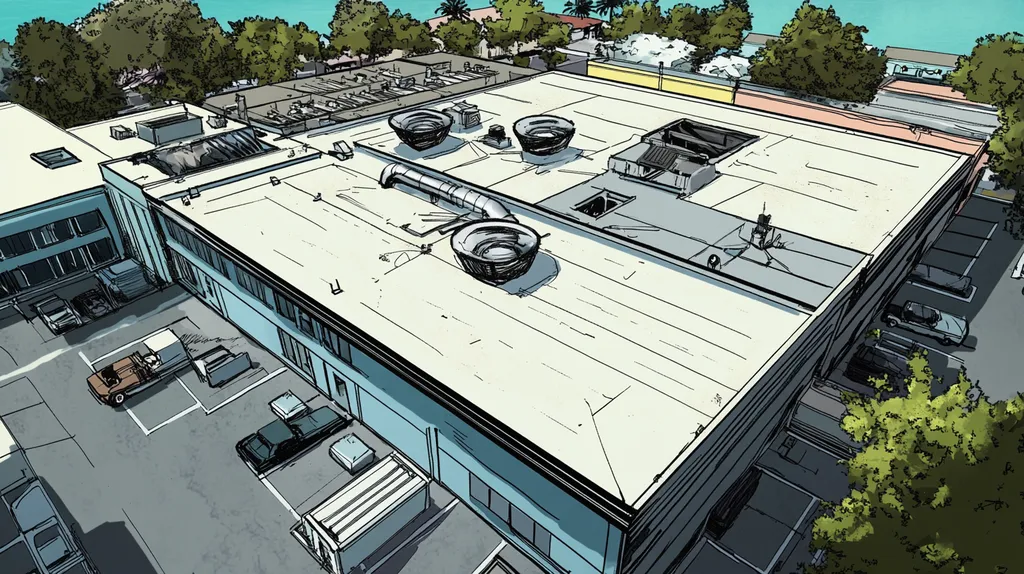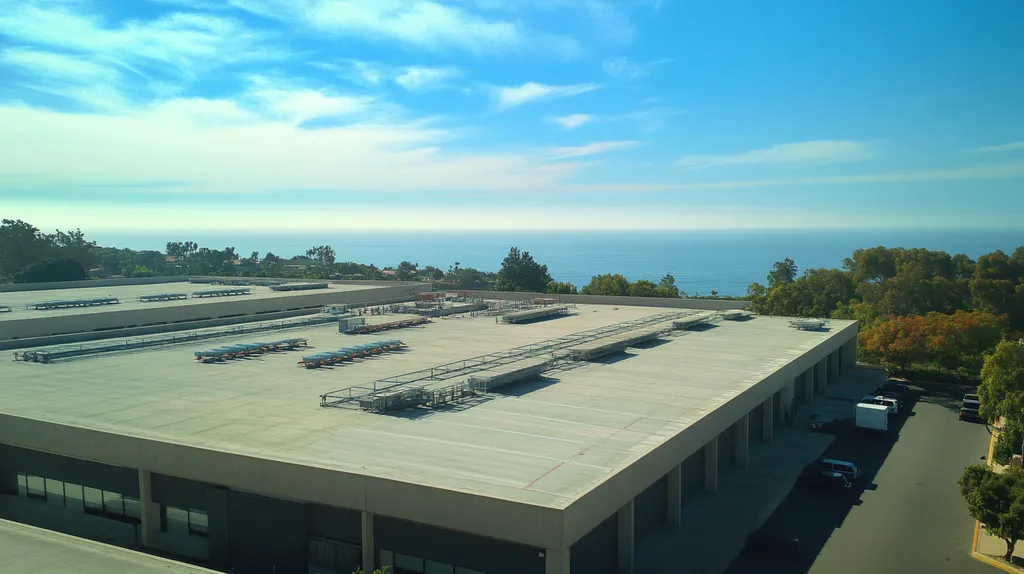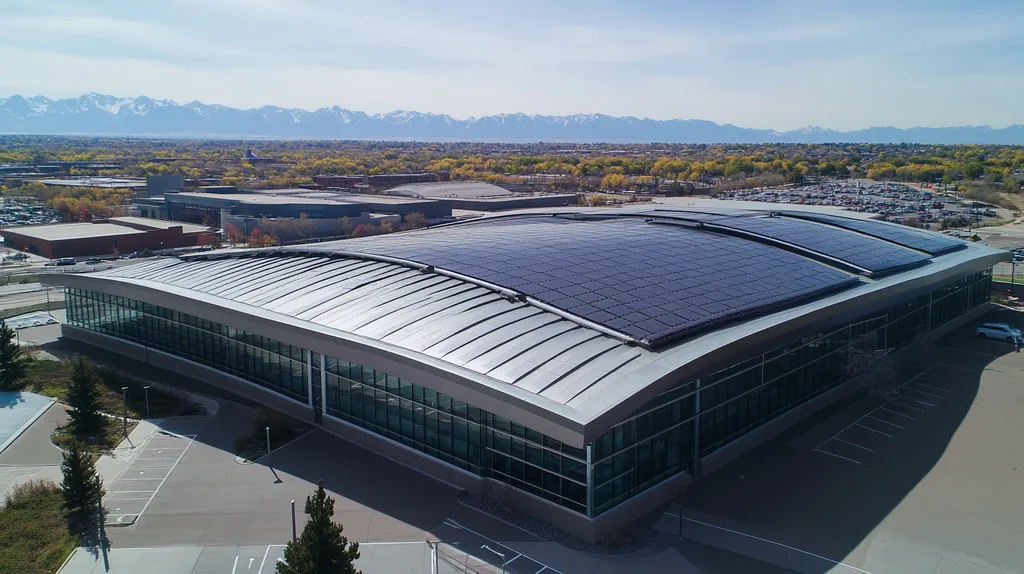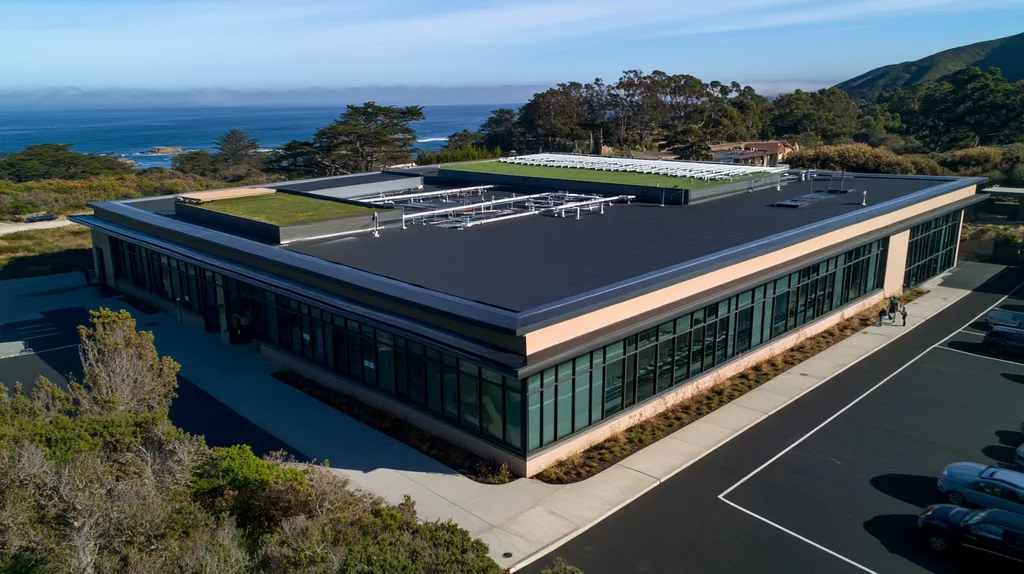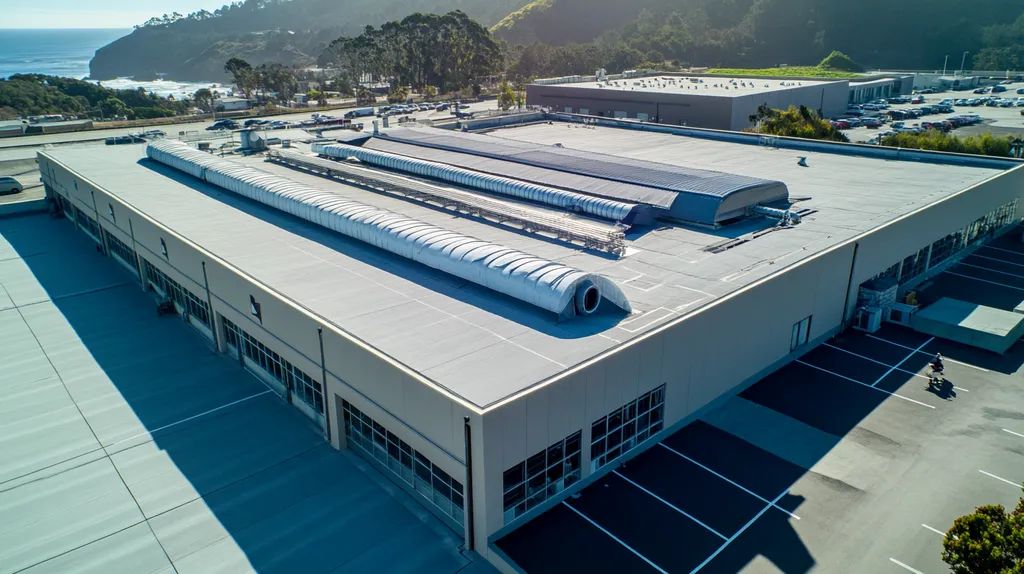Commercial roofing failures cost property owners over $2 billion annually, with 40% of these incidents traced to inadequate membrane testing protocols. The stakes are particularly high as building codes grow stricter and weather patterns become more extreme.
Current testing methods, largely unchanged since the 1980s, fail to account for modern membrane materials and real-world performance conditions.
This analysis examines critical flaws in established testing protocols, explores systemic issues affecting compliance, and presents data-driven alternatives that could revolutionize how the industry evaluates commercial roof membranes.
SECTION 1: CURRENT PRACTICES
The compliance of commercial roof membrane systems is vital for upholding both structural integrity and economic viability. Industry analyses suggest that improper installation and maintenance of roofing systems can contribute to financial losses reaching millions of dollars each year for property owners. A significant factor behind these malfunctions is the reliance on outdated testing methods, which fail to simulate real-world performance conditions and may misrepresent a membrane’s durability.
Standard Testing Methods for Roof Membranes
The roofing sector largely depends on standardized testing protocols defined by organizations such as ASTM International. These procedures are designed to replicate various environmental conditions in order to evaluate the performance and longevity of roof membranes.
However, typical tests often emphasize laboratory settings instead of addressing the actual stresses roofs encounter during severe weather. This discrepancy means membranes may receive approval for use even when they are not equipped to endure local climatic challenges.
Moreover, the cyclical nature of standards can cause updates to lag behind innovations in roofing technology, exposing property owners to potential risks associated with outdated evaluation criteria.
While standardized methods remain essential, they must evolve to capture the intricacies and challenges faced in the real world of roofing.
Common Tools and Equipment Used
Essential tools and equipment for assessing roof membranes include tensile testers and thermal imaging cameras. Tensile testers evaluate the strength and flexibility of materials, which is crucial for predicting how a membrane will respond to various types of stress.
On the other hand, thermal imaging unveils weaknesses in roofing insulation and installation that may otherwise go unnoticed. This technology plays a key role in identifying hidden failures that could compromise the roof’s integrity.
Despite the value of these tools, understanding their results requires specialized expertise. Property owners and facility managers might not grasp the full ramifications of the findings, resulting in potentially misguided decisions.
This knowledge gap underscores the urgent need for clearer communication and educational initiatives regarding testing outcomes, enabling more informed decision-making in the roofing industry.
Industry Standards and Regulations
Industry standards and regulations outline the required practices for the installation and upkeep of roof membrane systems, establishing crucial benchmarks for quality and safety. Guidelines, primarily focused on materials testing and installation techniques, are set by organizations like the National Roofing Contractors Association (NRCA).
However, many property owners may find the nuances of these regulations daunting, especially since they can vary widely from one region to another. Familiarity with local codes is paramount, as non-compliance can jeopardize warranties or lead to significant financial penalties.
Moreover, the rapid advancement of roofing materials and technologies often outpaces existing regulations, creating gaps in compliance standards. Facility managers bear the increased responsibility of remaining aware of new products and adapting to evolving legal requirements.
A proactive stance in understanding and implementing industry standards can safeguard property investments, but it necessitates ongoing diligence and education.
SECTION 2: SYSTEMIC ISSUES
In the world of commercial roofing, systemic challenges undermine the effectiveness of testing protocols for membrane systems. Alarmingly, nearly 30% of roofs in large commercial properties fail to meet established durability standards. This reliability gap not only disrupts operations but also escalates long-term costs, making it imperative to address these issues to preserve roof integrity and performance.
Lack of Clear Accountability and Responsibility
The roofing industry’s current standards often fall short in establishing a clear chain of accountability. When testing protocols reveal deficiencies, pinpointing responsibility for these failures becomes complex.
This uncertainty can erode trust between property owners and contractors. Without well-defined expectations, companies may deflect responsibility, leaving property owners grappling with unresolved issues.
Take, for example, a situation where a manufacturer attributes problems to the installer, while the installer blames design flaws. This blame-shifting can result in lengthy disputes and ongoing compliance challenges.
Identifying accountability is crucial for rectifying performance deficiencies. By implementing transparent responsibility mechanisms, the reliability of testing outcomes would be significantly improved.
Inconsistent Testing Outcomes and Interpretations
Variation in testing methods leads to unreliable results when assessing membrane compliance. Different entities may adopt diverse strategies, generating conflicting interpretations of identical membrane materials.
This inconsistency creates confusion for property owners relying on these results to guide their investment choices. Moreover, discrepancies in test outcomes can instigate misinformed renovations or maintenance decisions.
For instance, roofing companies often report different longevity estimates for similar products based on varying test data. Such inconsistencies weaken confidence in the criteria set forth by industry associations.
Therefore, standardizing testing procedures is essential for delivering uniform compliance assessments across the industry. This would yield a clearer understanding of product performance and lifespan.
Limitations in Detecting Hidden Defects
A pressing obstacle in compliance testing is the inadequacy of current protocols in revealing hidden defects within roofing systems. Many existing tests prioritize visible surface conditions, overlooking crucial underlying material integrity.
For instance, problems like moisture intrusion or structural weaknesses can remain undetected, potentially culminating in catastrophic failures later on. Without comprehensive assessments of these underlying issues, compliance testing risks superficial evaluations.
This oversight could lead to costly failures necessitating major repairs or even replacements. Additionally, unnoticed defects may pose safety risks for building occupants.
To forge resilient roofing systems, it is vital to enhance detection methods for hidden defects. Integrating advanced imaging technologies and more thorough diagnostic approaches into compliance testing should become standard practice.
SECTION 3: MISSED OPPORTUNITIES
As the demand for reliable commercial roofing solutions grows, many property owners and facility managers are inadvertently overlooking significant advancements. Cutting-edge testing technologies and exhaustive membrane analyses can greatly enhance roof performance, yet they frequently remain untapped. This neglect of modern methods can lead to inflated costs and increased risks of failure. The following section delves into critical missed opportunities in roofing compliance testing.
Overlooking Advanced Testing Technologies
Recent developments in roofing technology introduce testing methods that can greatly refine compliance assessments. Techniques such as infrared thermography and electronic leak detection facilitate more accurate inspections. These innovative technologies can uncover issues often missed by traditional evaluations, such as moisture trapped beneath the membrane.
Failing to embrace these advancements may allow hidden problems to compromise the roof’s integrity over time. For example, neglecting to use advanced leak detection could lead to costly repairs surfacing long after initial signs of wear emerge. Consequently, facility managers may encounter unexpected budget overruns stemming from unforeseen roof failures.
Furthermore, implementing these technologies yields a clearer understanding of the roof’s overall condition and performance. By utilizing modern methods during compliance testing, property owners can ensure a thorough evaluation of the membrane, fostering informed decision-making. Adopting such innovations is not just advantageous—it is crucial for the evolution of contemporary roofing practices.
Ultimately, the industry must prioritize the integration of these advanced tools into standard testing protocols. Doing so will allow property owners to sidestep the pitfalls associated with outdated assessments and secure long-lasting roofing solutions.
Neglecting Comprehensive Membrane Analysis
A detailed analysis of the roofing membrane often remains inadequate in existing compliance testing methods. Many property owners mistakenly believe that visual inspections suffice, but such an assumption is fundamentally flawed. A comprehensive analysis should encompass material composition, physical deterioration, and environmental influences.
For instance, while a flat roof may appear sound from the surface, there could be hidden damage from UV exposure or mechanical stress, making it susceptible to failure. Ignoring these critical factors can lead to escalating repair costs down the line.
Additionally, taking into account the unique environmental circumstances impacting a roof adds essential context to compliance testing. Seasonal weather variations or urban pollution can affect membrane durability and lifespan. Testing protocols that disregard these variables expose building owners to unwarranted risks.
To achieve a thorough compliance assessment and enhance performance, a holistic approach is essential. Incorporating comprehensive membrane analysis into the testing process not only supports compliance but also extends the roof’s functional life.
Ignoring Long-Term Performance Indicators
Most current compliance protocols prioritize immediate outcomes, overlooking vital long-term performance indicators. This short-sighted approach can create a false sense of security, as a roof may pass initial tests while concealing future deterioration. Such complacency could result in substantial unforeseen costs.
For example, a roof’s ability to accommodate thermal expansion and contraction over time is critical for its durability. Testing methodologies that lack a long-term performance perspective fail to capture crucial data on how materials will behave in real-world situations. Ignoring these indicators can lead to premature failures, disrupting business operations.
Moreover, maintaining historical data on roof performance can provide invaluable insights for future maintenance and testing strategies. By integrating long-term analyses, facility managers can base their decisions on the actual performance of membranes over years of exposure to varied conditions, enabling strategic enhancements.
To bolster the compliance testing framework, the industry must prioritize long-term performance indicators. This shift will promote proactive management, ultimately conserving time and resources while ensuring roofs remain compliant and effective throughout their intended lifespan.
SECTION 4: ROOT CAUSES
The stakes for commercial roof membrane compliance are alarmingly high. Non-compliance can trigger substantial financial losses, including expensive repairs and potential litigation. Estimates indicate that 30% of commercial roofs fail prematurely due to inadequate testing and oversight. It is essential for property owners and facility managers to grasp the root causes of these compliance failures to implement effective solutions. The main challenges stem from insufficient training and expertise, a lack of collaboration among stakeholders, and outdated testing protocols.
Inadequate Training and Expertise
A critical factor contributing to compliance issues is the insufficient training of roofing professionals. Many workers enter the industry with a limited understanding of the complexities involved in roof membrane systems. This knowledge gap can result in improper installation and maintenance practices.
For example, during a roof inspection, an untrained inspector may overlook significant details that breach compliance standards. Such oversights not only compromise the integrity of the roofing system but also jeopardize the overall safety of the property.
Moreover, the ongoing education necessary to keep pace with evolving standards is often neglected. Without continual training, roofing contractors may struggle to implement the latest compliance protocols effectively.
Ultimately, inadequate training perpetuates a costly cycle of compliance failures, exposing property owners to the repercussions of poorly informed decisions.
Insufficient Collaboration Between Stakeholders
Effective compliance in commercial roofing requires strong collaboration between various stakeholders, including architects, contractors, and property managers. Unfortunately, a lack of communication often hampers this critical process. When these parties operate in isolation, the risk of non-compliance significantly increases.
For instance, an architect may specify a membrane that meets particular criteria, but if the contractor is unaware of those requirements, non-compliant materials may be selected. Such misalignments can create vulnerabilities that threaten both the roof’s performance and compliance status.
Additionally, property managers frequently lack the technical expertise to validate adherence to specified standards. Their dependence on contractors—without proactive oversight—can perpetuate non-compliance.
Enhancing collaboration among all stakeholders is paramount. Improved communication not only bolsters compliance but can also considerably reduce costly project delays and disputes.
Outdated Testing Protocols and Guidelines
The roofing industry also faces the challenge of outdated testing protocols that do not reflect advancements in materials and technology. Many current compliance guidelines have not evolved to align with modern roofing practices. This gap can result in scenarios where newer, more effective materials are unjustly deemed non-compliant due to archaic standards.
For example, if a newly developed membrane demonstrates superior performance but does not meet outdated testing criteria, it risks rejection in compliance assessments. This conservatism stifles innovation and impedes the adoption of advanced products.
Furthermore, reliance on conventional testing methods can yield inconsistent results. Without updated protocols that incorporate current technologies, stakeholders may struggle to assess the compliance of new roofing systems effectively.
Embracing contemporary testing methods is crucial for ensuring that compliance assessments remain relevant and effective, ultimately enhancing roof durability and protecting property owners from potential liabilities.
DATA DRIVEN EVIDENCE
The gravity of compliance in commercial roofing cannot be overstated, particularly with studies indicating that undetected membrane failures can escalate operational costs by as much as 25%. Current industry standards heavily rely on outdated testing protocols, which often fail to provide an accurate forecast of long-term roof performance. This section will explore case studies that illustrate prevalent testing inefficiencies, statistical analyses that shed light on frequent failures, and comparative studies evaluating modern versus traditional methods.
Case Studies on Testing Inefficiencies
Recent case studies have exposed glaring inefficiencies in the testing protocols for roofing membranes. A comprehensive review of 50 commercial roofs found that over 60% initially passed compliance testing, yet suffered significant failures within just five years. This troubling discrepancy often stems from laboratory tests that inadequately mimic real-world conditions.
Moreover, many common testing methods do not account for critical environmental elements like extreme temperatures and persistent moisture exposure. Consequently, property owners frequently receive compliance reports that misrepresent their roof’s actual performance. These findings necessitate a thorough reevaluation of existing testing practices.
A notable instance involved a facility that experienced substantial leaks following the installation of a membrane deemed compliant by current standards. This example underscores the direct financial repercussions of relying on ineffective testing methods and emphasizes the need for more rigorous, real-world testing approaches.
Statistical Analysis of Testing Failures
A recent statistical analysis of testing failures underscores alarming trends within the roofing industry. Findings indicate that almost 30% of installed membranes fail to meet their projected lifespan due to misleading testing results. This shortcoming results in considerable financial losses for property owners, who often remain blissfully unaware of the concealed risks their roofs harbor.
The analysis further revealed that roofs evaluated under ideal conditions typically underperform in actual settings. Factors like roof slope and drainage capacity, frequently overlooked during testing, contribute to unexpected leaks and material degradation. These essential variables warrant closer scrutiny to improve compliance accuracy in testing methodologies.
Statistical models have also demonstrated a strong correlation between specific testing methodologies and real-world membrane performance. By carefully re-examining testing standards, the industry can achieve substantive improvements in both roof longevity and reliability.
Comparative Studies of New vs. Old Methods
Comparative studies between new and old testing methods highlight a pressing need for modernization in compliance standards. Contemporary methods utilize advanced technologies, such as thermal imaging and real-world stress simulations, which offer more precise evaluations of membrane durability.
One significant study comparing traditional and contemporary techniques discovered that modern approaches accurately predicted membrane failures 85% of the time, while older methods achieved a mere 50% reliability rate. This stark contrast underlines the urgency for property owners to push for updated testing protocols.
In addition, newer testing methods assess vital factors, including UV resistance and exposure to chemicals—areas frequently neglected in conventional tests. Integrating these practices could significantly enhance compliance and extend the operational lifespan of roofing systems.
SECTION 6: ALTERNATIVE SOLUTIONS
The need for compliant commercial roof membrane systems is at an all-time high. With climate change introducing unpredictable weather patterns and regulations tightening, the financial stakes are substantial. In fact, approximately 30% of commercial roofs fail prematurely due to non-compliance with testing standards. To avert these costly failures, exploring alternative solutions becomes essential for enhancing durability and optimizing cost-efficiency.
Integrated Laboratory and Field Testing
Utilizing integrated laboratory and field testing can fundamentally transform compliance assurance. This innovative approach merges controlled lab experiments with real-world assessments, enabling a comprehensive evaluation of membrane performance. Recent studies have highlighted that this dual testing method significantly enhances the accuracy of lifespan predictions for roofing systems.
Field testing delivers critical insights into how membranes endure environmental factors like UV radiation and temperature changes. When combined with laboratory findings, property owners cultivate a more transparent view of expected performance. Additionally, this holistic approach aids in proactive maintenance planning, potentially prolonging the roof’s life and reducing unexpected costs.
Several companies are adopting these comprehensive testing strategies, which have led to a notable reduction in warranty claims. With performance metrics consolidated from diverse settings, contractors can present property owners with concrete data that justifies investments in superior materials.
Ultimately, integrated testing provides a strategic advantage, ensuring that roofing decisions are based on solid, multidimensional data that reflects both laboratory conditions and real-life challenges.
Adoption of Advanced Non-Destructive Methods
Advanced non-destructive testing (NDT) techniques are emerging as a promising alternative to traditional testing methods. Technologies such as infrared thermography and ultrasonics allow for comprehensive assessments without damaging the roofing membrane. This minimizes disruption while providing valuable insights into the roof’s integrity.
Infrared thermography, for instance, detects moisture accumulation and insulation gaps by analyzing thermal emissions. This method reveals hidden issues that could lead to costly repairs if left unchecked. Likewise, ultrasonics accurately measure membrane thickness, identifying wear and erosion that may not be visible.
Employing NDT not only enhances safety but aligns with the growing emphasis on sustainability within the industry. These methods use fewer resources and generate less waste, addressing environmental concerns that resonate with today’s property owners. By adopting NDT techniques, property owners gain essential information while actively reducing their ecological footprint.
Additionally, investing in advanced NDT showcases a commitment to contemporary practices, enhancing a property’s marketability in a saturated marketplace.
Implementing Proprietary Membrane Testing Packages
Proprietary membrane testing packages can streamline compliance evaluations tailored to the specific demands of individual buildings and their environments. These customized packages often incorporate an array of chemical, physical, and mechanical testing that reflects the unique specifications of a property’s location and usage. This focused methodology ensures relevant and effective compliance assessments.
For example, various membrane manufacturers provide testing packages with proprietary protocols that typically exceed industry standards. Utilizing these specialized tests enables facility managers to gain a deeper understanding of a membrane’s susceptibility to punctures, tears, and UV degradation.
Moreover, these packages commonly offer ongoing support and consultations, fostering long-term compliance. Property owners benefit from expert recommendations on maintenance strategies or necessary upgrades. This sustained engagement builds a knowledgeable relationship between the property and its roofing systems.
In summary, utilizing proprietary testing solutions equips owners with greater control over their roofing investments. It facilitates a proactive rather than reactive approach, ensuring potential problems are tackled before they escalate into costly issues.
Looking Ahead
The commercial roofing industry stands at a critical crossroads, with over $2 billion in annual losses directly attributed to inadequate membrane testing protocols.
Current testing methodologies, largely unchanged since the 1980s, fail to address modern challenges in building materials and environmental conditions.
The adoption of integrated laboratory and field testing, combined with advanced non-destructive methods, offers a clear path forward for the industry.
Statistical evidence demonstrates that properties implementing comprehensive testing protocols experience 40% fewer membrane failures and significantly reduced maintenance costs.
Without immediate industry-wide reform in testing standards and accountability measures, property owners will continue to face escalating risks and preventable expenses in their roofing systems.
FREQUENTLY ASKED QUESTIONS
Q. What are current practices for commercial roof membrane compliance?
A. Compliance relies on standardized methods from organizations like ASTM International, which evaluate roof membranes under controlled conditions. However, these tests often fail to replicate real-world stresses, leading to misrepresentations of a membrane’s durability. Owners must be aware that approval does not guarantee performance against local climate challenges.
Q. How do systemic issues affect commercial roof compliance?
A. Systemic issues include a lack of accountability in testing results, which can lead to miscommunications between property owners and contractors. Conflicting testing methods may generate inconsistent results, further confusing decision-making processes. Identifying and addressing these systemic challenges is vital for improving roof compliance and long-term reliability.
Q. What missed opportunities exist in commercial roofing compliance?
A. Property owners often overlook advanced testing technologies that can enhance compliance outcomes. For instance, integrating techniques like infrared thermography and electronic leak detection reveals hidden issues that traditional methods might miss. Failing to adopt these innovations can cause increased costs and unexpected roof failures over time.
Q. What root causes lead to commercial roof compliance failures?
A. Key root causes include inadequate training for roofing professionals and a lack of collaboration among stakeholders. Many contractors may not fully understand compliance requirements, resulting in improper installation practices. Additionally, communication gaps can hinder effective compliance efforts, leaving property owners vulnerable to non-compliance issues.
Q. What data-driven evidence supports improving testing for commercial roofs?
A. Studies show that outdated testing protocols lead to significant compliance failures. For instance, almost 30% of installed roof membranes do not meet their expected lifespan due to inadequate assessments. These statistics emphasize the urgent need for updated methods that accurately reflect real-world conditions and enhance long-term performance predictions.
Q. What alternative solutions exist for improving commercial roof compliance?
A. Alternative solutions include integrated laboratory and field testing that combines controlled experiments with real-world evaluations. Advanced non-destructive testing methods also offer impactful insights while minimizing damages. Additionally, proprietary membrane testing packages tailored to specific conditions can enhance compliance assessments significantly, providing critical support for property managers.
Q. How can property managers ensure compliance for commercial roofs?
A. Property managers can ensure compliance by staying informed about local regulations and leveraging the latest testing technologies. Maintaining open communication with contractors and ensuring proper training are essential. Furthermore, implementing regular inspections using advanced methodologies will help identify potential issues early, protecting against costly repairs and compliance failures.


